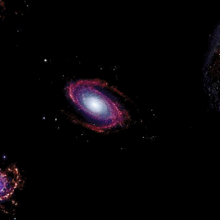Big Crunch Theory
The Great Implosion, also known as the Great Collapse or directly by the English term Big Crunch, is one of the cosmological theories that are being considered in the 21st century about the final destiny of the universe.
The Big Implosion theory proposes a closed universe. According to this theory, if the universe has a critical density, the expansion of the universe, produced by the Big Bang (or Big Bang) will gradually slow down until finally all the elements that make up the universe begin to approach each other again. make up the universe, recompressing matter into a space-time singularity.
It was theorized that, if the expansion was generated by the energy of the Big Bang, the speed of the expelled particles would finally be reduced, because of the attraction between the bodies with matter, because in front of them in the path of expansion there was no matter. Matter, we could say, would work as a ballast for infinite expansion. That is why it was believed that the moment in which the expansion of the universe would end up stopping, and the contraction would begin; Said moment depends on the critical density of the universe: the higher the density, the faster the braking and contraction; and the lower the density, the more time for events to unfold. If the density is low enough, a perpetually expanding universe is predicted to take place.
Recent experimental evidence (particularly the observation of distant supernovae as standard candles and full mapping of the microwave background radiation) has led to speculation that the expansion of the universe is not slowing down due to gravity, but rather slowing down. speeding up. However, because the nature of dark energy—which is postulated as the source of the acceleration—is unknown, it is still possible (although not supported by observation to date) that the universe will eventually reverse gear and cause a collapse.
This phase of contraction would follow inexorably, and with it the increase in the temperature of radiation and matter. There would come a time when all the galaxies would merge into one – although collisions between stars would still be rare. Meanwhile, the temperature of the radiation background would rise and begin to endanger the survival of the life forms that existed at that time, initially those that lived on terrestrial planets. At a given moment, said temperature would be 300 kelvins, preventing the aforementioned planets from getting rid of their accumulated heat and ending up making them uninhabitable. Later on, and with an increasingly accelerated contraction –and along with it a runaway increase in the temperature of cosmic radiation– the universe would become a hellish and uninhabitable place –at least for beings like us and without technological help– with temperatures of thousands of degrees due to cosmic radiation at that temperature and collisions between stars as they have less and less space.
Apparently, the stars would be mostly destroyed not by collisions with each other but by the increase in temperature of the universe. This would become so hot that the stars could not get rid of the heat accumulated inside and would begin to absorb it from the outside (cooking in a certain way), until they ended up exploding. After that, only black holes would remain (the main fact that would differentiate the contraction phase from the expansion phase) and an increasingly hot plasma (very different from that existing after the birth of the universe because it would come from structures that have already disappeared, therefore which would show a great asymmetry in the density that it presented at different points) in which the increase in temperature would first destroy the atoms and then the elementary particles themselves, only leaving quarks. Finally, the black holes would finish merging with each other and absorbing the matter around them, giving rise to a single "super" black hole. Just as there is no point in asking what was "before" after the Big Bang, you can't wonder what would come "after" of the Great Implosion.
Swinging Universe
According to this theory, the universe would be described as an oscillating Universe, in which, after the Big Implosion, Big Crunch could take place; and even this universe could come from a previous universe that also collapsed in its Big Implosion. If this had happened repeatedly, we would find ourselves before an oscillating universe; where each universe ends with a Big Bang and gives rise to a new universe with a Big Bang. However, not only is it not known what could cause such a rebound, but the theory of an oscillating universe contradicts the second law of thermodynamics; unless in each cycle there was a total destruction and reset of the universe, with the disappearance of existing physical laws and the appearance of new physical laws, and/or entropy was "rewinded"; during the contraction phase (for example, it has been suggested that time would go backwards during this phase), not only would the number of black holes increase in each cycle, but the existing radiation in the universe would increase at the expense of matter – due to the nuclear fusion reactions produced inside the stars, in which part of the matter that makes up the merging atoms is transformed into energy–, with the result that the "rebounds" they would be longer and longer until reaching a scenario not too different from indefinite expansion; All of this would have the consequence that there should have been a finite number of cycles before the current one. In addition, the recent discovery of dark energy has caused many cosmologists to abandon the theory of this oscillating universe and, along with other discoveries, also the theory that the universe is closed, although the nature of dark energy is not well known yet, it cannot be a future collapse can be completely ruled out.
Contenido relacionado
Precession
(4015)Wilson-Harrington
Geostationary orbit
